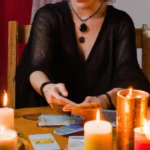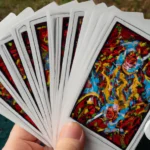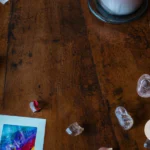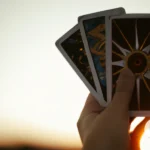The world of tarot cards can be captivating and mysterious, holding answers to questions we may not even know we have. Whether you’re a seasoned practitioner or a curious beginner, learning to interpret tarot cards for self-reflective purposes can be a valuable tool for personal growth. Tarot cards have been used for centuries to gain insight into the past, present, and future, and they can also shed light on our innermost desires and fears. In this guide, we’ll explore the basics of tarot, how to prepare for a reading, and how to use the cards for self-reflection. So grab your deck and let’s dive in!
Understanding Tarot Cards
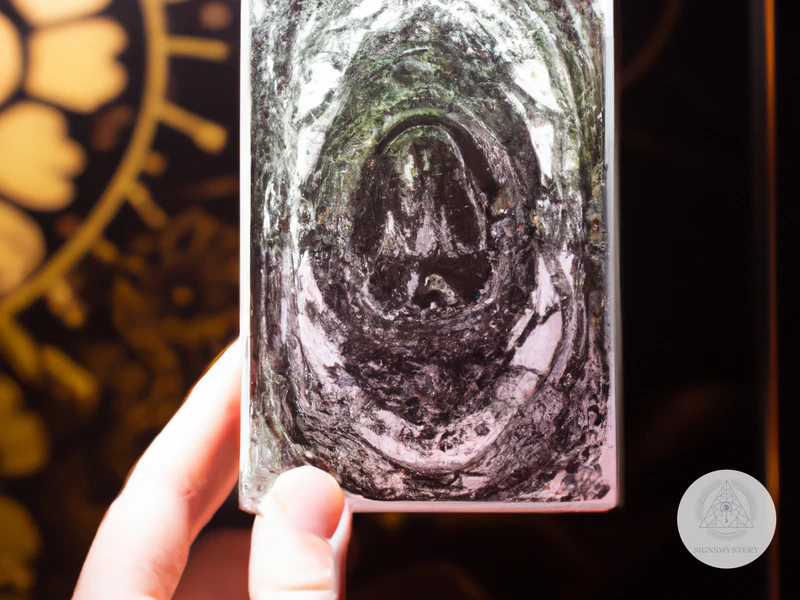
Tarot Cards have been used for centuries as a tool for divination and self-reflection. These cards are illustrated with symbols and imagery that hold deep meaning and can offer insights into various aspects of our lives. The origins of Tarot are shrouded in mystery, but it is believed to have its roots in ancient Egypt and the Middle East. Today, Tarot is commonly used for personal growth and reflection, as well as by professional readers for spiritual guidance and divination. Understanding the different components of Tarot, such as the Major and Minor Arcana, and the various Tarot spreads available, can help you gain a deeper understanding of yourself and your life’s path. For those seeking more information about Tarot and self-reflection, there are many resources available online, including articles, spreads, and guides on how to use Tarot for personal growth and self-awareness.
What are Tarot Cards?
Tarot cards are a deck of 78 cards often used for divination and self-reflection purposes. The cards are divided into two distinct sections: the Major Arcana and the Minor Arcana. The Major Arcana contains 22 cards that represent major life events or turning points, while the Minor Arcana contains 56 cards that are further divided into four suits: cups, wands, pentacles, and swords. Each suit represents a different aspect of life, such as emotions, creativity, material wealth, and mental clarity, respectively. The suits also contain four court cards: the Page, Knight, Queen, and King. Each card has a unique meaning and symbolism, which can be interpreted in various ways based on the context of the reading and the intuition of the reader.
Tarot cards are often used as a tool for self-discovery and reflection because the cards can reveal hidden truths and insights about one’s life. When interpreting the cards, it’s crucial to approach the reading with an open mind and a willingness to explore any messages or themes that arise. The cards can be drawn in a variety of spreads, which are configurations of cards that provide insight into different aspects of life, such as love, career, and personal growth.
Using tarot cards for self-reflection can be a powerful way to connect with one’s inner self and gain a deeper understanding of one’s emotions, desires, and fears. By asking specific questions and examining the cards’ messages, individuals can gain clarity and insight into their current circumstances and potential future outcomes. The use of tarot cards can be combined with other mindfulness practices, such as meditation and journaling, to further enhance the reflective experience.
Although tarot cards have a rich history and cultural significance, their true power lies in their ability to provide guidance and insight for personal growth and reflection. By engaging with the symbols and messages of the cards, individuals can tap into their intuition and explore the inner workings of their psyche. Whether used alone or in combination with other tools, such as oracle cards or mindfulness practices, tarot cards can be a valuable resource for anyone seeking to discover more about themselves and their life journey.
The Major and Minor Arcana
When interpreting Tarot cards, it’s essential to understand the distinction between the Major and Minor Arcana. There are 78 cards in a Tarot deck, with 22 Major Arcana cards and 56 Minor Arcana cards.
The Major Arcana cards represent significant life events and spiritual lessons that we will encounter on our journey. These cards feature characters such as The Fool, The Magician, and The Tower, and they can indicate major turning points in our lives. When a Major Arcana card appears in a reading, it’s often a sign that significant change is on the horizon that will require us to grow and evolve.
On the other hand, Minor Arcana cards represent the day-to-day aspects of our lives. The Minor Arcana is divided into four suits: Cups, Wands, Swords, and Pentacles (or Coins). Each suit has ten numbered cards and four court cards (Page, Knight, Queen, King). Cards in the Minor Arcana provide more specific information about our experiences, emotions, and the people around us.
Remember that every card in a Tarot reading is essential, whether it’s from the Major or Minor Arcana. Each card is a piece of the puzzle, and together, they tell a story about our past, present, and potential future.
For those interested in learning more about self-reflection with Tarot cards, it’s important to familiarize oneself with these fundamental concepts to better understand the messages of the cards.
Tarot Spreads
refer to the layout or arrangement of tarot cards during a reading. Each spread has a different purpose and can be used to answer specific questions or provide general guidance. Here are some of the most popular tarot spreads:
| Spread Name | Purpose | Number of Cards |
|---|---|---|
| Celtic Cross | Provides insight into a specific situation or question | 10 |
| Three-Card Spread | Offers a simple answer to a yes or no question or a basic overview of a situation | 3 |
| Relationship Spread | Focuses on the dynamics between two people, whether romantic, platonic, or professional | 7 |
| Self-Reflection Spread | Provides guidance for personal growth and self-understanding | 6 |
It’s important to select a spread that aligns with your intentions or question. If you are seeking insight into a specific aspect of your life, such as your career or relationships, choose a spread that corresponds to that theme. Conversely, if you want a general overview or guidance for personal development, a self-reflection spread may be more appropriate.
It’s also worth noting that you can create your own spreads or modify existing ones to suit your needs. Don’t be afraid to experiment and adapt spreads to fit your specific situation or inquiry.
For those who are new to tarot, it may be helpful to begin with a simple spread, such as a three-card or one-card draw, to become familiar with the process and symbolism of the cards. As you become more comfortable with tarot, you can explore more complex spreads and deepen your understanding of the cards’ messages.
Using tarot spreads in combination with other self-reflective tools, such as journaling or meditation, can enhance the introspective and mindful nature of tarot readings. Consider incorporating tarot into your daily mindfulness practice or exploring other types of oracle cards, such as /connecting-inner-self-oracle-cards/ or /self-reflection-oracle-cards/.
Preparing for a Tarot Reading
Preparing for a tarot reading is an important part of the process as it helps to set the tone and intention for the reading. First, it’s important to set an intention for the reading. This can be as simple as asking the cards to provide guidance or insight on a specific situation or question. Next, create a sacred space for the reading. This can be done by lighting candles, burning sage or incense, or playing calming music. Finally, shuffle the deck while focusing on the intention set earlier. This helps to infuse your energy into the deck and sets the stage for an accurate reading. By being intentional and mindful in the preparation stage, you can have a more meaningful and insightful tarot reading. For more information on using tarot cards for self-awareness and mindfulness, check out our article on tarot mindfulness and self-awareness.
Setting an Intention
One of the most important steps in preparing for a tarot reading is setting an intention. This means deciding on the purpose of the reading and what you hope to gain from it. It’s essential to have a clear goal in mind before beginning the reading as it will help you focus your energy and give the cards direction.
To set an intention, start by asking yourself what area of your life you want to focus on. Is it your career, love life, or personal growth? Once you have identified the area, think about what specific question you want to ask the cards. It’s crucial to frame the question in a positive way that focuses on what you want, rather than what you don’t want.
For example, instead of asking, “Why am I always unlucky in love?” rephrase the question to something like, “What can I do to attract a loving, healthy relationship?” This type of positive framing helps to set the right mindset and encourages the cards to give guidance that will help you achieve your goals.
It’s also helpful to write down your intention and keep it nearby during the reading. This serves as a physical reminder of your goal and helps you stay focused on the task at hand. When you have a clear intention, it’s much easier to interpret the cards’ messages and apply them to your life.
Keep in mind that setting an intention does not mean trying to control the outcome of the reading. Instead, it’s about being open to receiving guidance and insight that can help you move forward in a positive direction. Trust that the cards will reveal what you need to know, even if it’s not always what you expected.
Setting an intention is an essential step in preparing for a tarot reading. It helps you focus your energy, gives the cards direction, and encourages you to approach the reading with a positive mindset. Take the time to form a clear intention, and you’ll be setting yourself up for a more insightful and meaningful experience.
Creating a Sacred Space
Creating a Sacred Space is an essential step in preparing for a Tarot reading. It involves setting up a space that is calm and serene, free from any distractions, and imbued with positive energy.
Here are some tips on how to create a Sacred Space for your Tarot reading:
| Step 1: | Cleanse the area. Before you start setting up your Sacred Space, it’s essential to clear the energy in the room. You can do this by burning sage, palo santo or cedar, or using any other method that resonates with you. |
| Step 2: | Choose meaningful objects. Select objects that hold special meaning for you, such as crystals, candles, or incense. You could also consider adding fresh flowers or plants to bring some life to the space. |
| Step 3: | Create a relaxing atmosphere. Use soft lighting or candles to create a calm ambiance, and consider playing gentle meditation music in the background to help you relax and focus your mind. |
| Step 4: | Add personal touches. Incorporate elements that reflect your personality and style, such as artwork, favorite colors, or decorative items that hold special significance. |
| Step 5: | Set your intention. Take a few deep breaths and set an intention for your Tarot reading as you enter your Sacred Space. This could be as simple as asking for clarity, insight, or guidance. |
Remember, your Sacred Space is your own, and you know best what works for you in creating a peaceful and meaningful environment. Taking the time to set up a Sacred Space will help you connect with your intuition and guide your Tarot reading towards personal growth and self-discovery.
Shuffling the Deck
Shuffling the Deck is an important step in preparing for a tarot reading. It helps to clear the energy and create a blank slate for the cards to convey their messages. Here are some techniques to consider when shuffling the deck:
| Technique | Description |
|---|---|
| Overhand Shuffle | This technique involves splitting the deck in half and holding one half in each hand. Cards from one hand are released onto the other hand, creating chunks of shuffled cards. |
| Riffle Shuffle | This method involves holding the deck in one hand and using the thumb to bend the cards downward. The other hand uses its fingers to release cards into the bend, creating a riffle effect. The cards are then shuffled back together. |
| Knocking on the Deck | This is a simple but effective technique. The deck is held in one hand and lightly knocked onto a surface or table. This helps to disperse the cards and clear the energy. |
| Cutting the Deck | Divide the deck into two piles, place one on top of the other, and shuffle. After shuffling, cut the deck into three piles with the left hand and re-stack using the right hand, or merge the piles back together in a different order. |
No matter which technique is chosen, it’s important to make sure the cards are shuffled thoroughly. It’s also recommended to shuffle with intention, thinking about the reason for the reading and inviting positive energy to flow through the cards. Take the time to connect with the deck and allow the cards to guide the way.
Interpreting the Cards
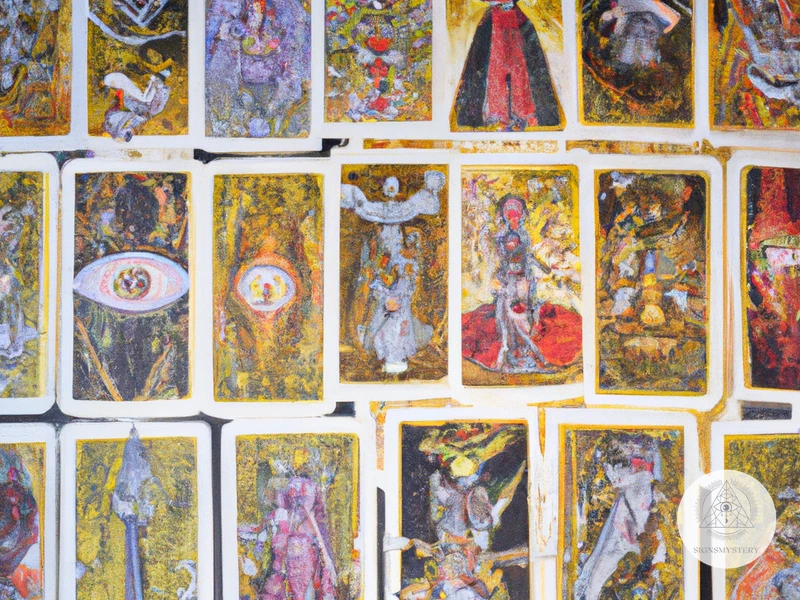
Interpreting the cards is a crucial part of performing a tarot reading. Each card has its own unique meaning and symbolism, making it essential to understand the symbols before trying to interpret the card’s message. One strategy for interpreting the cards is to pay attention to the cards’ position in the tarot spread. For example, a card in the “past” position may represent something that has already happened, while a card in the “future” position may represent something that has yet to come. Another approach to interpreting the cards is to use intuition and look for patterns or themes in the cards. Journaling your interpretations can also help you reflect and revisit your understanding of the cards over time. By using all of these techniques, you can develop a deep understanding of the meaning behind each card, and use that knowledge to provide insightful self-reflection and guidance.
Understanding the Symbols
Understanding the symbols within tarot cards is a crucial step in interpreting them for self-reflective purposes. Each card contains a range of symbols that work together to convey a message or theme. Some symbols may be more obvious, while others require deeper exploration of the card’s imagery.
Symbols often have multiple interpretations and meanings, depending on the context of the card and the question being asked. For example, the sun symbol can represent warmth, growth, and positivity, but can also indicate arrogance or overconfidence.
The moon may represent intuition, secrets, or subconscious thoughts. Meanwhile, the star can symbolize hope, guidance, and inspiration.
It’s important to note that symbols can also change in meaning depending on the deck being used. Different artists may choose to depict symbols in varying ways, adding their own interpretations to the cards.
To gain a deeper understanding of the symbols within tarot cards, it’s helpful to keep a symbol reference guide on hand and do research on common interpretations. Additionally, pay close attention to the symbols that appear frequently in readings, as this can indicate patterns or recurring themes in your life.
Understanding the symbols within tarot cards is an essential step in interpreting them for self-reflective purposes. Taking the time to study and explore the meanings behind each symbol can provide clarity and insight into personal growth and development.
Using Intuition
When interpreting tarot cards, intuition plays a vital role. You may feel an immediate connection with a card or a particular symbol on the card, even if you don’t understand its meaning at first glance. Trusting your instincts and following your gut feelings can often lead to a more accurate interpretation.
One way to develop your intuition is to study the art and symbolism of tarot cards, becoming familiar with their meanings and how they relate to each other. With practice, you’ll begin to notice patterns and recurring themes in your readings. Pay attention to
Subscribe to Our Newsletter
Sign up to receive the latest news and updates.
Another technique for tapping into your intuition is to allow yourself to be fully present and focused during the reading. Take a few deep breaths, quiet your mind and body, and allow yourself to be open to whatever messages may come through the cards. If you find yourself getting distracted or doubting your intuition, take a break and return to the reading later when you feel more centered.
Remember, there is no right or wrong way to interpret tarot cards. Trust your intuition, and allow the cards to guide you on your journey of self-reflection and discovery.
Journaling Your Interpretations
Journaling your interpretations after a tarot reading is an essential part of the process. It allows you to record your thoughts, feelings, and insights and reflect on them at a later time. Here are some tips to make the most out of your journaling practice:
| Tip #1: | Write down the card(s) you pulled and their position in the spread. This will help you remember the context of your reading. |
| Tip #2: | Start with your initial reactions to the cards. What emotions did they evoke? What symbols stood out? |
| Tip #3: | Use your intuition to explore the meanings of the cards. What do the symbols and colors mean to you? How do they relate to the question or intention you set? |
| Tip #4: | Think about the cards in the context of your life and personal experiences. How do they relate to your current circumstances? |
| Tip #5: | Consider the advice or message the cards are offering you. How can you apply it to your life? |
| Tip #6: | Reflect on the reading as a whole. What patterns or themes emerged? Was there anything that surprised you? |
| Tip #7: | Set aside time to revisit your journal entries. Look for insights you may have missed initially and track your progress over time. |
By taking the time to journal your interpretations, you can deepen your relationship with the tarot and gain greater clarity and guidance from your readings. Remember to approach your journaling practice with an open mind and heart, and let the insights flow naturally.
Applying Tarot to Self-Reflection
One unique application of tarot cards is using them as a tool for self-reflection. By asking open-ended questions and examining the cards’ messages, individuals can gain insights into their own emotions, behaviors, and personal themes. Tarot cards can serve as a guide for inner exploration, providing a visual representation of unconscious thoughts and patterns. By reflecting on the cards’ meanings and exploring personal themes, individuals can gain a deeper understanding of themselves, their desires, and their relationships with others. It’s important to approach tarot for self-reflection with an open mind and a willingness to explore the unknown. Through this practice, individuals can gain greater clarity and self-awareness.
Questions to Ask the Cards
Asking the right questions is essential when trying to interpret tarot cards for self-reflective purposes. The right questions will help you dig deep into your subconscious and uncover the truths that are waiting to be discovered. Here are some examples of questions that you can ask the cards to get started:
| Question | Description |
| What do I need to know about myself right now? | This question will help you gain some insight into your current situation and what aspects of your life need attention. |
| What is blocking me from achieving my goals? | Asking this question can help you identify the obstacles that are holding you back and give you an idea of what you need to work on to move forward. |
| What can I do to improve my relationship with myself/others? | This question can help you gain clarity on your relationships and what you can do to make them stronger and healthier. |
| What steps can I take to achieve my desired outcome? | If you have a goal in mind, asking the cards this question can help you identify the actionable steps you can take to make it happen. |
| What do I need to let go of to move forward? | Letting go of certain things can be difficult, but this question can help you identify what you need to release in order to make progress in your life. |
| What is the lesson that I need to learn from this situation? | Every situation in life has a lesson to be learned. This question can help you identify the wisdom that you can gain from a particular experience. |
Remember that the questions you ask should be open-ended and allow for interpretation. Avoid asking yes or no questions, as they don’t leave much room for exploration and self-discovery. Take your time with each question, and allow the cards to guide you towards the answers that you seek.
Examining the Cards’ Messages
When examining the cards’ messages in a tarot reading, it’s important to take a close look at each card drawn and consider its specific meanings and symbolism. Remember to approach each card with an open mind and consider all of its possible interpretations.
Start by looking at the card as a whole. Notice any colors, patterns, or imagery that stand out to you. Consider the general feel or mood of the card, whether it’s light and airy or dark and ominous.
Next, focus on the individual symbols within the card. Each symbol has its own unique meaning and can add depth and nuance to the overall message of the card. Pay attention to any animals, people, objects, or elements that appear within the card, and consider what they might represent.
Finally, think about how the card’s message relates to your current situation or question. What insights or guidance does the card offer? How can you apply its message to your life?
Remember, each card in a tarot reading is like a piece of a puzzle, and it’s only by examining each piece closely that you can begin to see the bigger picture. Trust your intuition and be open to unexpected insights and messages that may arise during your examination of the cards.
Reflecting on Personal Themes
Reflecting on personal themes is one of the most powerful ways to use tarot cards for self-reflection. By exploring the themes that emerge in a reading, you can gain deeper insights into your inner world and identify areas where growth and healing are needed. Here are some tips for reflecting on personal themes after a tarot reading:
- Identify the major themes. Look at the cards that appeared in your reading and identify any recurring symbols, colors, or themes. For example, if you drew several cards related to love and relationships, you may want to reflect on how you show love to yourself and others, or whether you are giving or receiving enough love in your life.
- Ask probing questions. Once you have identified the major themes, use open-ended questions to explore them more deeply. For example, if your theme is related to career or work, you might ask yourself “What is my soul’s purpose in my career?” or “How can I find greater fulfillment and joy in my work?”.
- Find connections to your life. As you reflect on the themes that emerged in your tarot reading, try to find connections to your daily life. For example, if a card related to creativity appeared, you may want to explore ways to incorporate more creativity into your work or hobbies.
- Take action steps. Finally, after reflecting on your personal themes, it’s important to take concrete steps towards growth and healing. This might involve setting intentions, making changes in your daily routine, or seeking support from a therapist, coach, or trusted friend.
Remember, self-reflection is a powerful tool for personal growth and transformation. By using tarot cards to explore your inner world, you can gain valuable insights and clarity on your path forward. Take your time with this process, and be gentle with yourself as you explore your personal themes and take steps towards growth and healing.
Closing Thoughts
Closing Thoughts:
As you can see, using tarot cards for self-reflective purposes can be a powerful tool for gaining insight and understanding oneself on a deeper level. However, it’s important to remember that tarot readings are not a substitute for professional therapy or medical advice. While they can provide valuable guidance and support, they should not be relied upon as the sole means of dealing with personal issues.
One important thing to keep in mind when using tarot cards for self-reflection is to approach the practice with an open mind and a willingness to be honest with yourself. The cards may reveal truths or insights that you may not have been aware of before, and it’s important to be receptive to this information.
Additionally, it’s important to remember that tarot readings are not set in stone and can be subject to interpretation. While the cards may provide guidance or insight, it’s ultimately up to the individual to use their own judgment and intuition when applying the information to their life.
Tarot cards can be a powerful tool for self-reflection and personal growth. By understanding the symbols and interpreting the messages of the cards, individuals can gain a deeper understanding of themselves and their personal themes. However, it’s important to approach tarot card readings with an open mind, use your intuition, and remember that they should be used as a supplement to professional therapy and not a replacement.
Frequently Asked Questions
What is the history of tarot cards?
Tarot cards were first used as playing cards in Europe during the 14th century. They were later adapted for divination purposes during the 18th century by occultists.
Do you have to be psychic to read tarot cards?
No, you do not need to be psychic to read tarot cards. Anyone can learn to read tarot with practice and an open mind.
How many cards are in a tarot deck?
There are 78 cards in a standard tarot deck. They are divided into the Major Arcana and Minor Arcana.
What is a tarot spread?
A tarot spread is the layout of cards used during a tarot reading. There are many different spreads, each with a specific purpose and number of cards used.
Can you do a tarot reading for yourself?
Yes, you can do a tarot reading for yourself. However, it is recommended to seek the guidance of a professional tarot reader for more complex issues.
What is the significance of each tarot card?
Each tarot card has a unique meaning and symbolism. Their significance depends on the context of the spread and the interpretation of the reader.
How often should you do a tarot reading for self-reflection?
There is no set frequency for tarot readings. It is recommended to do one when you are in need of guidance or clarity.
Can tarot cards predict the future?
No, tarot cards do not predict the future. They offer guidance and insight into the present moment and potential outcomes based on the current trajectory.
What should you do if you draw a “negative” card during a self-reflective reading?
When drawing a “negative” card during a self-reflective reading, it is important to examine the message of the card and identify areas of growth or change. Use it as an opportunity for self-improvement rather than a cause for concern.
What are some common self-reflective questions to ask during a tarot reading?
Some common self-reflective questions include: “What is holding me back from achieving my goals?”, “What areas of my life require more attention?”, and “What lessons can I learn from my past experiences?”.






